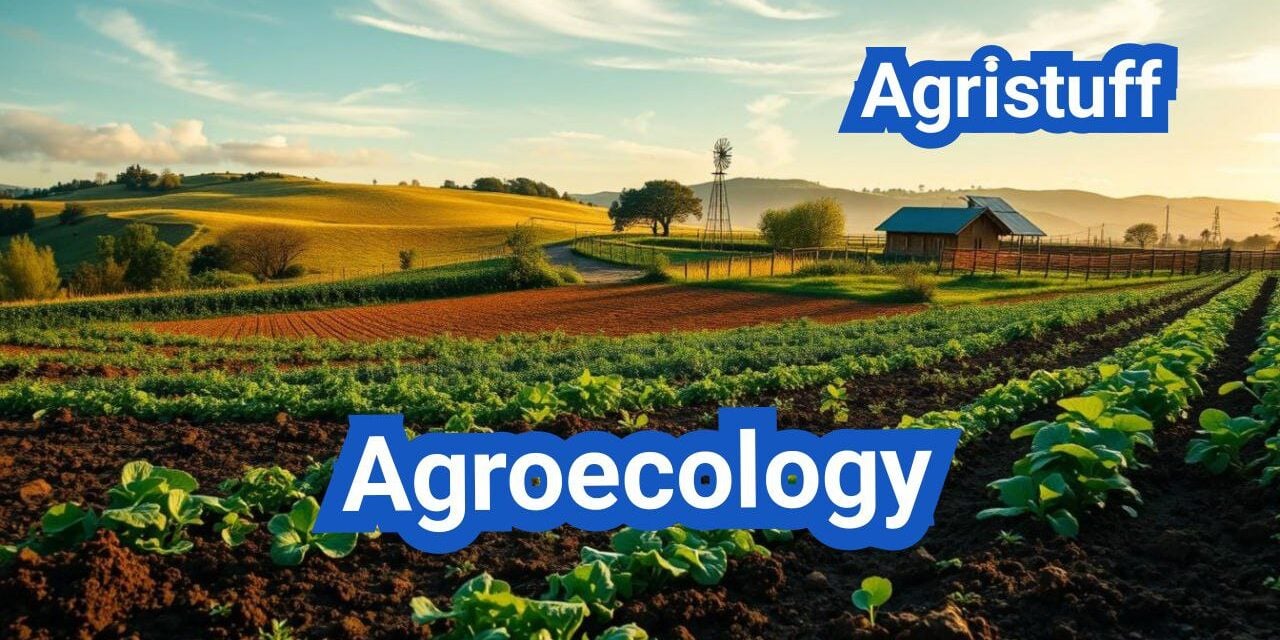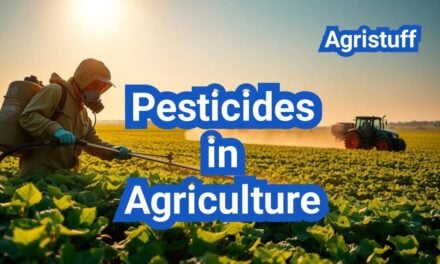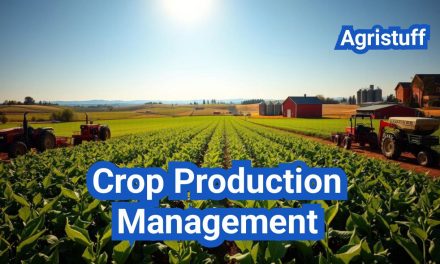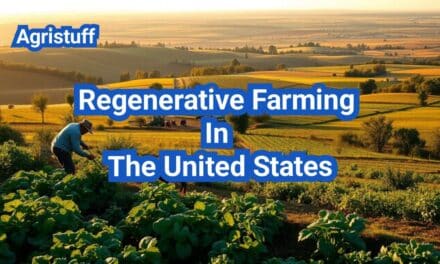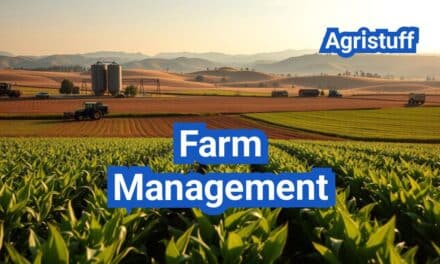The world is facing unprecedented challenges, from resource degradation to climate change, threatening the very foundation of our agricultural systems. In response, agro ecology has emerged as a vital approach to promoting resilient farming practices.
Agroecology is more than just a farming method; it’s a holistic philosophy that integrates ecological principles into agricultural production. By focusing on the interconnectedness of soil, plants, and ecosystems, agroecology aims to enhance biodiversity, improve soil health, and boost farm productivity.
As the global community seeks sustainable agriculture solutions, agroecology offers a promising path forward. By adopting regenerative agriculture practices, farmers can contribute to a more resilient food system.
Key Takeaways
- Agroecology is a holistic approach to farming that integrates ecological principles.
- It aims to enhance biodiversity, improve soil health, and boost farm productivity.
- Agroecology offers a promising path towards sustainable agriculture.
- Regenerative practices can contribute to a more resilient food system.
- Agroecology is crucial for promoting resilient agricultural systems.
What is Agro Ecology? A Holistic Approach to Sustainable Farming
At its core, agroecology is about understanding and working with nature to create sustainable farming systems that benefit both the environment and human communities. This approach to farming is gaining recognition for its potential to address some of the most pressing issues in agriculture today.
The Definition and Evolution of Agroecology
Agroecology is defined as a holistic approach to farming that applies ecological principles to agricultural systems. It involves the integration of natural and human resources to produce food in a way that is not only sustainable but also enhances the overall well-being of farmers and local communities.
The evolution of agroecology is rooted in the need to move away from conventional farming practices that often rely heavily on chemical-synthetic inputs, which can have detrimental effects on the environment and human health.
Bridging Ecological Science and Agricultural Practice
One of the key strengths of agroecology is its ability to bridge the gap between ecological science and agricultural practice. By applying the principles of ecology to farming, agroecology seeks to create farming systems that are not only productive but also resilient and sustainable over the long term.
This is achieved through practices such as crop rotation, cover cropping, and the integration of livestock into farming systems.
The Triple Bottom Line: Environmental, Social, and Economic Benefits
Agroecology is unique in that it aims to achieve a triple bottom line of environmental, social, and economic benefits. Environmentally, agroecology promotes practices that enhance biodiversity, improve soil health, and reduce the need for external inputs.
Socially, it supports the well-being of farmers and local communities by promoting equitable and just farming practices. Economically, agroecology can improve the viability of farming operations by reducing costs associated with external inputs and enhancing the value of local products.
| Benefits | Description | Impact |
|---|---|---|
| Environmental | Promotes biodiversity, improves soil health, reduces external inputs | Enhances ecosystem services, reduces environmental degradation |
| Social | Supports equitable and just farming practices, enhances community well-being | Improves the livelihoods of farmers and local communities |
| Economic | Reduces costs associated with external inputs, enhances local product value | Increases the viability and profitability of farming operations |
Core Principles of Agroecological Systems

At the heart of agroecological systems are a set of guiding principles designed to promote ecological health and agricultural productivity. These principles work together to create a holistic farming approach that prioritizes sustainability and resilience.
Ecological Balance and Biodiversity
Ecological balance is crucial in agroecology, achieved through the promotion of biodiversity. This involves diversifying crops, maintaining soil health, and conserving natural habitats within the farm landscape. Biodiversity is key to a resilient ecosystem, providing a range of benefits including improved soil health, enhanced pollination, and natural pest control.
- Diversifying crop and animal species to enhance ecosystem services
- Maintaining and improving soil health through organic amendments and minimal disturbance
- Conserving and restoring natural habitats for beneficial organisms
Resource Cycling and Efficiency
Agroecological systems emphasize the importance of resource cycling and efficiency. This involves minimizing external inputs by recycling nutrients and energy on the farm. Practices such as composting, cover cropping, and integrating crops and livestock help to achieve this goal, reducing waste and enhancing the overall efficiency of the farming system.
- Implementing composting programs to recycle organic waste
- Using cover crops to improve soil health and reduce erosion
- Integrating crops and livestock to optimize resource use and reduce waste
Resilience Through Diversity
Diversity is a cornerstone of resilience in agroecological systems. By diversifying crops, livestock, and farming practices, farmers can reduce their vulnerability to environmental stresses and market fluctuations. This diversity also contributes to a more dynamic and adaptable farming system, better equipped to respond to changing conditions.
Integration of Traditional and Scientific Knowledge
The integration of traditional and scientific knowledge is a key principle of agroecology. This involves combining the best of traditional farming practices with modern scientific understanding to create innovative and effective farming solutions. By valuing both types of knowledge, farmers can develop more holistic and sustainable farming systems.
- Documenting and applying traditional farming practices
- Incorporating scientific research and technology to improve farming practices
- Fostering collaboration between farmers, researchers, and extension agents
By embracing these core principles, agroecological systems can enhance ecological health, improve agricultural productivity, and contribute to a more sustainable food system.
Building Soil Health: The Foundation of Resilient Agriculture
Healthy soils are the foundation upon which resilient agricultural systems are built, supporting biodiversity and ecosystem functions. Soil health is critical for maintaining ecological balance, promoting agricultural productivity, and ensuring the long-term sustainability of farming practices.
Understanding Soil as a Living Ecosystem
Soil is a complex, living ecosystem that supports a vast array of biological, chemical, and physical processes. It is home to a diverse range of organisms, from bacteria and fungi to insects and earthworms, which play crucial roles in decomposing organic matter, cycling nutrients, and structuring soil.
Soil biodiversity is essential for maintaining soil health, as it contributes to the ecosystem services that soils provide, including carbon sequestration, water filtration, and support for plant growth.
Key Indicators of Healthy Agricultural Soils
Healthy agricultural soils exhibit certain characteristics that indicate their overall health and functionality. These include:
- Good structure and aeration
- Adequate organic matter content
- Active biological communities
- Good water infiltration and retention
- Sufficient nutrient supply
Monitoring these indicators helps farmers and land managers assess soil health and make informed decisions about management practices.
Biological Activity and Organic Matter Management
Biological activity is a key component of soil health, driving processes such as decomposition, nutrient cycling, and soil structure formation. Managing organic matter effectively is crucial for maintaining and enhancing biological activity.
Organic matter management strategies include incorporating cover crops, adding compost or manure, and minimizing tillage to preserve soil organic carbon and promote soil biota.
Soil Testing and Monitoring Protocols
Regular soil testing and monitoring are essential for assessing soil health and identifying areas for improvement. This involves analyzing soil physical, chemical, and biological properties.
| Soil Property | Indicators | Management Implications |
|---|---|---|
| Soil Organic Carbon | Content and quality of organic matter | Influences soil structure, fertility, and carbon sequestration |
| Soil pH | Acidity or alkalinity | Affects nutrient availability and microbial activity |
| Soil Biological Activity | Microbial biomass, respiration | Indicates soil’s ability to support ecosystem services |
By understanding soil as a living ecosystem and implementing practices that enhance its health, farmers can build more resilient agricultural systems that are better equipped to withstand environmental challenges and support ecosystem services.
Cover Cropping Strategies for Soil Protection and Enhancement

Cover cropping is a vital practice in agroecology that protects and enhances soil health between crop cycles. By incorporating cover crops into their rotations, farmers can significantly improve soil structure, increase biodiversity, and reduce erosion.
Selecting the Right Cover Crops for Your System
The selection of cover crops depends on several factors, including climate, soil type, and the specific goals of the farmer. Some cover crops, like legumes, are excellent for nitrogen fixation, while others, such as rye or oats, are better suited for reducing soil erosion.
- Legumes: Beans, peas, and clover are examples of legumes that fix atmospheric nitrogen, making it available for subsequent crops.
- Grasses: Grasses like rye, oats, and barley help in reducing soil erosion and improving soil structure.
- Brassicas: Crops like radish and turnip can help break up compacted soil and suppress pests.
Implementation Techniques for Maximum Benefit
Effective implementation of cover crops involves several techniques. These include choosing the right seeding rates, ensuring proper soil preparation, and timely termination of the cover crops.
- Seeding Rates: The optimal seeding rate varies depending on the cover crop species and the desired outcome.
- Soil Preparation: Preparing the soil properly before seeding cover crops can enhance their establishment and growth.
- Termination Timing: Terminating cover crops at the right time is crucial to avoid competition with the subsequent cash crop.
Managing Cover Crop Termination and Transition
Terminating cover crops effectively is critical to ensure a smooth transition to the next crop. Techniques include mechanical termination, chemical termination, and incorporating the cover crop residue into the soil.
Farmers must consider the most appropriate termination method based on their specific farming system, equipment availability, and environmental considerations.
Measuring Cover Crop Impact on Soil Health
Assessing the impact of cover crops on soil health involves monitoring various indicators, including soil organic matter, soil structure, and biodiversity.
| Indicator | Description | Benefit |
|---|---|---|
| Soil Organic Matter | Increased organic matter content | Improved soil fertility and structure |
| Soil Structure | Enhanced aggregation and porosity | Better water infiltration and aeration |
| Biodiversity | Increased microbial and faunal activity | Enhanced ecosystem services |
By carefully selecting and managing cover crops, farmers can significantly enhance soil health, contributing to more resilient and sustainable agricultural systems.
Designing Effective Crop Rotations in Agroecological Systems
Effective crop rotation is a cornerstone of agroecological farming, enhancing soil health and biodiversity. By carefully planning crop sequences, farmers can improve soil fertility, reduce pest and disease pressure, and increase overall farm resilience.
Planning Multi-Year Rotation Sequences
Planning multi-year rotation sequences involves considering the long-term effects of different crops on soil health and ecosystem services. A well-designed rotation sequence can help in maintaining soil organic matter, improving nutrient cycling, and supporting beneficial soil organisms.
- Consider the crop families and their characteristics.
- Plan for a mix of cash crops and cover crops.
- Incorporate legumes to enhance nitrogen fixation.
Balancing Cash Crops with Soil-Building Phases
Balancing cash crops with soil-building phases is crucial for maintaining economic viability while improving soil health. Soil-building phases involve planting cover crops or incorporating organic amendments to enhance soil fertility and structure.
- Identify cash crops that are economically viable.
- Integrate cover crops to improve soil health.
- Monitor soil health indicators to adjust rotation plans.
Adapting Rotations to Local Conditions
Adapting crop rotations to local conditions requires understanding the specific climate, soil type, and pest pressures of the farm. Local adaptation can significantly impact the effectiveness of crop rotations.
- Assess local climate and soil conditions.
- Consult with local agricultural experts.
- Use local data to inform rotation decisions.
Documentation and Assessment Tools
Utilizing documentation and assessment tools is essential for evaluating the effectiveness of crop rotations. Farm records and soil testing can provide valuable insights into the impact of rotations on soil health and crop productivity.
| Tool | Purpose | Benefits |
|---|---|---|
| Farm Records | Track crop yields and soil health over time. | Inform future rotation decisions. |
| Soil Testing | Assess soil nutrient levels and structure. | Identify areas for improvement. |
Integrating Livestock in Agroecological Grazing Systems

Integrating livestock into agroecological grazing systems represents a pivotal strategy for enhancing farm resilience and biodiversity. This approach not only improves ecosystem services but also contributes to more productive and sustainable agricultural practices.
Principles of Managed Rotational Grazing
Managed rotational grazing is a cornerstone of integrating livestock into agroecological systems. This practice involves moving livestock to different grazing areas to allow previously grazed areas to recover. The key principles include:
- Optimizing grazing periods to prevent overgrazing and allow for adequate rest periods.
- Monitoring forage availability to ensure that livestock have sufficient feed without degrading the pasture.
- Adjusting stocking rates based on forage production and weather conditions.
Multi-Species Grazing Benefits
Multi-species grazing, which involves grazing different types of livestock together, can enhance the overall efficiency and ecological benefits of grazing systems. The benefits include:
- Increased biodiversity by utilizing different forage preferences among livestock species.
- Improved parasite control as different species have different parasite burdens.
- Enhanced ecosystem services through the diverse impacts of different grazing animals on vegetation structure and composition.
Monitoring and Adjusting Grazing Impact
Continuous monitoring of grazing impact is crucial for the success of agroecological grazing systems. This involves assessing indicators such as:
- Forage utilization rates.
- Soil health indicators, including compaction and erosion.
- Water quality and availability.
Adjustments to grazing management are made based on these assessments to maintain or improve the health and productivity of the grazing system.
Infrastructure Needs for Adaptive Grazing
Effective infrastructure is essential for implementing managed rotational grazing and multi-species grazing. Key infrastructure elements include:
- Fencing that allows for the division of grazing areas and facilitates rotational grazing.
- Watering systems that provide adequate and clean water to livestock in all grazing areas.
- Handling facilities for managing livestock health, vaccinations, and other necessary interventions.
By carefully planning and managing these elements, farmers can create resilient and productive agroecological grazing systems that benefit both the environment and their agricultural enterprises.
Agroforestry: Combining Trees with Agricultural Production

By merging trees with farming systems, agroforestry creates diverse and resilient agricultural ecosystems. This practice not only enhances biodiversity but also promotes ecological interactions between trees and crops, leading to more sustainable farming systems.
Silvopasture and Alley Cropping Systems
Agroforestry practices include silvopasture and alley cropping systems, which are designed to maximize the benefits of integrating trees into agricultural landscapes. Silvopasture involves combining trees with pasture and livestock, creating a system where trees provide shade for animals, improve soil health, and increase biodiversity.
- Enhances livestock health and productivity
- Improves soil fertility through increased organic matter
- Diversity in ecosystem services
Alley cropping is another agroforestry practice where crops are grown between rows of trees. This system can improve soil health, reduce erosion, and increase overall farm productivity.
Windbreaks and Riparian Buffers
Windbreaks and riparian buffers are crucial components of agroforestry systems. Windbreaks are rows of trees or shrubs planted to protect crops from wind damage, reduce soil erosion, and create microclimates that can enhance crop growth.
- Reduces wind erosion and damage to crops
- Creates habitat for wildlife
- Can improve air quality
Riparian buffers are areas of vegetation, often including trees, along water bodies that help protect water quality by filtering out sediments and nutrients from runoff. They also provide habitat for various species and can stabilize riverbanks.
Tree Selection and Management for Multiple Benefits
The success of agroforestry systems depends significantly on the selection and management of trees. Trees can be chosen for their fruit, timber, or other products, as well as for their ecological benefits.
- Selecting tree species that are well-suited to the local climate and soil conditions
- Managing tree density to optimize benefits without competing with crops
- Pruning and maintaining trees for health and productivity
Economic Considerations in Agroforestry Systems
While agroforestry offers numerous ecological benefits, its adoption also depends on economic viability. Farmers can diversify their income streams through the sale of timber, fruits, and other products from trees integrated into their farming systems.
- Diversifies farm income
- Can improve long-term farm productivity
- Enhances ecosystem services that have economic value
Water Management in Agroecological Systems

Water management plays a crucial role in enhancing the resilience of agroecological practices. Effective water management is crucial in agroecological systems to enhance resilience to drought and other water-related challenges.
Soil Water Retention Strategies
Soil water retention is a critical aspect of water management in agroecological systems. Strategies to improve soil water retention include incorporating organic matter, using cover crops, and implementing conservation tillage. These practices help in reducing soil erosion and increasing the soil’s water-holding capacity.
Organic matter plays a significant role in improving soil structure, allowing it to retain more water. Cover crops help in reducing evaporation and runoff, while conservation tillage minimizes soil disturbance, preserving soil moisture.
Efficient Irrigation Approaches
Efficient irrigation is vital for minimizing water waste and ensuring that crops receive the right amount of water. Techniques such as drip irrigation and mulching can significantly reduce water usage. Drip irrigation delivers water directly to the roots of plants, reducing evaporation and runoff.
- Drip irrigation systems
- Mulching to retain soil moisture
- Precision irrigation technologies
Managing Water Quality and Runoff
Managing water quality is as important as managing water quantity. Agroecological systems can adopt practices like buffer strips and riparian zones to filter out sediments and nutrients from runoff water. This not only protects water bodies but also enhances biodiversity.
Buffer strips planted along water bodies can trap sediments and nutrients, improving water quality. Riparian zones provide habitat for various species and help in maintaining ecological balance.
Drought Resilience Planning
Drought resilience planning involves adopting strategies that help farms survive during periods of water scarcity. This includes selecting drought-tolerant crop varieties, improving soil water retention, and implementing efficient irrigation systems.
Drought-tolerant crops can survive with minimal water, reducing the impact of drought on agricultural productivity. Improving soil health through organic amendments and cover cropping enhances water retention, making farms more resilient to drought.
Ecological Pest Management Without Synthetic Chemicals

Ecological pest management strategies are crucial for sustainable farming practices that prioritize environmental health. By adopting a holistic approach to managing pests, farmers can reduce their reliance on synthetic chemicals, thereby protecting ecosystems and promoting biodiversity.
Building System Resilience to Pest Pressure
Building resilience to pest pressure involves diversifying crops, using crop rotations, and maintaining soil health. These practices contribute to a balanced ecosystem that is less susceptible to pest outbreaks. For instance, crop rotation can break the life cycle of pests, reducing their populations over time.
Diversification is key in agroecological systems. By growing a variety of crops, farmers can reduce the risk of pest damage. This approach also promotes ecological balance by providing habitat for beneficial insects.
Beneficial Insect Habitat and Management
Creating habitat for beneficial insects is a critical component of ecological pest management. This can be achieved by planting a diverse range of flora that provide nectar and pollen, which in turn support beneficial insect populations.
- Planting flowers that attract beneficial insects
- Maintaining ecological corridors
- Reducing pesticide use to protect beneficial species
Biological Controls and Minimal Intervention Strategies
Biological controls involve using living organisms to manage pest populations. This can include introducing natural predators or parasites of the pest species. Minimal intervention strategies, such as reducing chemical use, allow these natural processes to occur, maintaining ecological balance.
Biological control agents can be highly effective. For example, ladybugs are known to prey on aphids, reducing the need for pesticides.
Monitoring and Decision-Making Frameworks
Effective ecological pest management requires continuous monitoring of pest populations and their impact on crops. Decision-making frameworks help farmers assess the situation and choose the most appropriate management strategies.
Regular monitoring allows for early detection of pest issues, enabling timely intervention. This proactive approach can prevent pest populations from reaching damaging levels.
Creating and Supporting Pollinator Habitat

Incorporating pollinator-friendly practices into farming systems enhances overall ecosystem services. Pollinators, such as bees, butterflies, and other beneficial insects, play a crucial role in maintaining biodiversity and ensuring the reproduction of many plant species.
Designing Flowering Strips and Zones
Designing flowering strips and zones is a critical strategy for supporting pollinators. These areas are planted with a variety of flowers that provide nectar and pollen, serving as a food source for pollinators. When designing these strips, it’s essential to select a mix of plants that bloom at different times to provide a season-long food source.
The width and placement of flowering strips can vary depending on the farm’s layout and the specific pollinator species being targeted. Research suggests that wider strips and those placed in areas with high pollinator activity can be particularly effective.
Season-Long Bloom Sequences
Creating a season-long bloom sequence is vital to support pollinators throughout the growing season. This involves selecting a diverse range of plants that bloom in succession, ensuring a constant supply of nectar and pollen.
- Spring-blooming plants like clover and wildflowers
- Summer-blooming plants such as sunflowers and zinnias
- Fall-blooming plants including asters and goldenrod
By incorporating a mix of these plants, farmers can provide a continuous food source for pollinators, enhancing their health and populations.
Nesting Sites and Habitat Considerations
In addition to food sources, pollinators require nesting sites and habitat. Many pollinator species nest in the ground or in vegetation. Providing areas with undisturbed soil and maintaining diverse vegetation can support these nesting needs.
Farmers can create pollinator-friendly habitats by leaving some areas of the farm unmanicured, with native vegetation and minimal disturbance. This can include creating bee hotels or other nesting structures for solitary bees and other pollinators.
Measuring Pollinator Population Impact
To understand the effectiveness of pollinator conservation efforts, it’s crucial to measure pollinator populations and their impact on the farm. This can involve monitoring pollinator activity, assessing crop yields, and evaluating the overall health of pollinator populations.
Farmers can use various methods to monitor pollinators, including observational surveys, trap counts, and other monitoring techniques. By assessing the impact of their conservation efforts, farmers can make informed decisions to further support pollinator health.
Building Climate Resilience Through Agroecological Practices

As the world grapples with climate change, agroecological practices offer a promising pathway to building resilience in agricultural systems. Agroecology, with its focus on soil health, biodiversity, and efficient water use, provides a holistic approach to enhancing climate resilience.
Carbon Sequestration Strategies
One of the key strategies in building climate resilience is through carbon sequestration. Agroecological practices such as cover cropping, reduced tillage, and incorporating organic amendments help in capturing atmospheric carbon dioxide and storing it in soils. This not only mitigates climate change but also improves soil fertility and structure.
Implementing cover crops is a straightforward method to enhance carbon sequestration. By planting crops like legumes or grasses between crop cycles, farmers can increase soil organic matter, reduce erosion, and promote soil biota. For instance, a study on cover cropping in the Midwest United States found significant increases in soil organic carbon and improved soil health indicators.
Adapting to Weather Extremes
Agroecological systems are designed to be resilient to weather extremes, such as droughts and floods. Practices like mulching and conservation tillage help in retaining soil moisture and reducing the impact of drought. Similarly, improving soil’s water-holding capacity through increased organic matter can mitigate flood damage by allowing the soil to absorb more water.
- Using drought-tolerant crop varieties
- Implementing efficient irrigation systems
- Enhancing soil’s water-holding capacity
Compost and Biochar Applications
The application of compost and biochar is another critical strategy for enhancing climate resilience. Compost adds nutrients and improves soil structure, while biochar can sequester carbon for long periods. These amendments not only improve soil fertility but also contribute to carbon sequestration, making agricultural systems more resilient to climate change.
For example, incorporating biochar into soils has been shown to improve soil water retention, aeration, and nutrient availability, benefiting plant growth and reducing the need for synthetic fertilizers.
Measuring and Verifying Climate Benefits
To understand the effectiveness of agroecological practices in building climate resilience, it’s crucial to measure and verify their climate benefits. This involves monitoring soil carbon levels, tracking changes in soil health indicators, and assessing the overall resilience of the agricultural system to climate-related stresses.
By adopting a data-driven approach, farmers and policymakers can make informed decisions about the implementation and scaling of agroecological practices, ultimately enhancing climate resilience in agricultural systems.
Transitioning to Agroecological Practices: Implementation Guide

Transitioning to agroecological practices is a strategic move towards sustainable agriculture. This process involves a comprehensive assessment of current farming systems, followed by the implementation of practices that enhance ecological balance and biodiversity.
Assessment and Baseline Establishment
The first step in transitioning to agroecological practices is conducting a thorough assessment of the farm’s current condition. This includes evaluating soil health, biodiversity, water resources, and existing ecological pressures. Establishing a baseline is crucial for measuring future progress and identifying areas that require immediate attention.
Key assessment areas include:
- Soil testing to determine nutrient levels and structure
- Biodiversity surveys to identify existing flora and fauna
- Water quality and availability assessments
As noted by agroecology expert Miguel Altieri, “Agroecology is not just about increasing yields, but about creating a resilient farming system that works with nature, not against it.”
“Agroecology is an opportunity to rethink the way we produce food, focusing on the complex interactions between plants, animals, and the environment.”
Phased Implementation Strategies
Implementing agroecological practices should be done in phases to minimize disruption and allow for adjustments based on observed outcomes. The initial phase may involve introducing cover crops or adjusting crop rotations to improve soil health.
Phased implementation steps:
- Short-term changes (0-2 years): Introduce cover crops, adjust irrigation practices
- Medium-term changes (2-5 years): Implement crop rotations, integrate livestock
- Long-term changes (5+ years): Develop agroforestry systems, enhance biodiversity
Monitoring Progress and Adapting Management
Continuous monitoring is essential to assess the effectiveness of implemented agroecological practices. This involves regular soil testing, biodiversity monitoring, and yield assessments. Based on the data collected, management practices can be adapted to optimize outcomes.
Monitoring indicators:
- Soil organic matter content
- Presence and diversity of beneficial insects
- Water retention and infiltration rates
By following this implementation guide, farmers can successfully transition to agroecological practices, enhancing the sustainability and resilience of their agricultural systems.
The Future of Resilient, Soil-First Agriculture
The future of agriculture lies in adopting resilient, soil-first practices that prioritize ecological health and biodiversity. As we’ve explored, agroecology offers a holistic approach to sustainable farming, integrating ecological science with agricultural practice to achieve environmental, social, and economic benefits.
By focusing on soil health, farmers can build more resilient agricultural systems. Techniques such as cover cropping, crop rotation, and integrating livestock can significantly enhance soil fertility and structure, leading to improved crop yields and reduced environmental impact.
Adopting soil-first agriculture is crucial for long-term sustainability. It not only enhances the productivity of the land but also contributes to climate resilience by sequestering carbon and reducing the need for synthetic inputs.
As the global community continues to face challenges such as climate change, soil degradation, and biodiversity loss, the adoption of agroecological practices becomes increasingly important. By embracing resilient agriculture and soil-first practices, we can ensure a more sustainable food system for future generations.
FAQ
What is agroecology?
Agroecology is a holistic approach to sustainable farming that works with nature, focusing on the interactions between plants, animals, and their environment to promote ecological balance and biodiversity.
What are the core principles of agroecology?
The core principles of agroecology include ecological balance, resource cycling, resilience through diversity, and the integration of traditional and scientific knowledge to create sustainable agricultural systems.
How does agroecology contribute to soil health?
Agroecology contributes to soil health by promoting practices such as cover cropping, crop rotation, and organic amendments that enhance soil biodiversity, structure, and fertility.
What is the role of cover crops in agroecological systems?
Cover crops play a crucial role in protecting and enhancing soil health by reducing erosion, improving soil structure, and providing habitat for beneficial insects.
How can crop rotation be designed to promote ecological balance?
Crop rotation can be designed to promote ecological balance by planning multi-year rotation sequences that balance cash crops with soil-building phases, adapting to local conditions, and using documentation and assessment tools.
What are the benefits of integrating livestock into agroecological systems?
Integrating livestock into agroecological systems can provide benefits such as improved soil fertility, increased biodiversity, and enhanced ecosystem services through managed rotational grazing and multi-species grazing.
How does agroforestry contribute to agroecological systems?
Agroforestry contributes to agroecological systems by combining trees with agricultural production, enhancing biodiversity, improving soil health, and providing ecosystem services through practices such as silvopasture and alley cropping.
What are the key strategies for managing water in agroecological systems?
Key strategies for managing water in agroecological systems include soil water retention, efficient irrigation approaches, managing water quality and runoff, and drought resilience planning.
How can ecological pest management be achieved without synthetic chemicals?
Ecological pest management can be achieved without synthetic chemicals by building system resilience, managing beneficial insects, using biological controls, and implementing monitoring and decision-making frameworks.
What is the importance of pollinator habitat in agroecological systems?
Creating and supporting pollinator habitat is crucial in agroecological systems, as it enhances biodiversity and ecosystem services by designing flowering strips, maintaining season-long bloom sequences, and providing nesting sites.
How can agroecological practices contribute to climate resilience?
Agroecological practices can contribute to climate resilience by promoting carbon sequestration strategies, adapting to weather extremes, using compost and biochar applications, and measuring climate benefits.
What are the steps to transition to agroecological practices?
Transitioning to agroecological practices involves assessment and baseline establishment, phased implementation strategies, and monitoring progress to adapt management practices.
What is the significance of agroecology in sustainable agriculture?
Agroecology is significant in sustainable agriculture as it promotes resilient, soil-first systems that enhance ecological balance, biodiversity, and ecosystem services, contributing to a more sustainable food system.
Conclusion of: Agroecology
Agro ecology, in brief: why a soil-first mindset makes farms tougher
Agro ecology is a practical way to design farming so fields function like healthy ecosystems—diverse, efficient, and resilient—and for U.S. growers the first priority is soil. By centering agro ecology on soil biology, ground cover, and living roots, farms typically gain steadier yields, better water infiltration, and less vulnerability to input shocks, which is exactly what matters as climate and market volatility rise. FAO overview of agroecology
Agro ecology builds on four field-tested soil health principles
Agro ecology becomes actionable through four principles that guide day-to-day decisions: keep soil covered, minimize disturbance, maximize living roots, and maximize biodiversity. These principles translate into a sequence of crop and livestock practices that protect aggregates, feed microbes, and cycle nutrients, allowing agro ecology to scale from one field to the whole farm without all-or-nothing transitions. USDA NRCS: Soil Health
Agro ecology and resilience: why soil is your first risk-management tool
In production terms, agro ecology strengthens drought and deluge tolerance by increasing organic matter and pore space that store water and buffer heat, and by spreading biological risk through diverse rotations and habitats. Because risk increasingly comes from weather extremes, agro ecology’s soil-first approach reduces losses while maintaining yield stability across variable seasons. USDA Climate Hubs: resilience resources
Agro ecology and cost-share: funding the first steps
Getting started with agro ecology is easier when a conservation plan unlocks cost-share for design, seed, fencing, water points, and new management. Through EQIP and CSP, NRCS helps producers adopt cover crops, reduced tillage, grazing improvements, and agroforestry—often in a phased plan that fits cash flow and labor. USDA NRCS programs (EQIP, CSP)
Agro ecology planning: start small, measure, then scale
The smartest way to launch agro ecology is to target one constraint on one field, document a baseline, and add practices in steps. A conservation plan clarifies objectives, timelines, and monitoring so you can compare scenarios before investing; that discipline helps agro ecology become a durable system, not a one-off trial. NRCS conservation planning basics
Agro ecology rotations: diversify to spread risk and feed the soil
Diverse crop rotations are the backbone of agro ecology because they break pest and disease cycles, distribute workload, and feed a broader soil food web. Even a simple change—adding a small grain or a full-season legume—creates space for covers, manure applications, or grazing that compound soil benefits. NRCS: Conservation Crop Rotation
Agro ecology cover crops: living roots that drive nutrient cycling
Cover crops are the most common entry point to agro ecology because living roots feed microbes, capture excess nitrogen, and armor the surface against erosion. Species selection should match goals: grasses for biomass and erosion control, legumes for nitrogen, brassicas for bio-tillage and compaction relief, and mixes to stack functions. NRCS: Cover Crop (Practice 340)
Agro ecology and reduced tillage: protect aggregates, cut passes
Minimizing disturbance is central to agro ecology because tillage destroys soil structure and burns organic matter; switching to no-till or strip-till preserves aggregates, cuts fuel and labor, and keeps residue in place. Success depends on residue management, planter setup, and an herbicide resistance plan while biology re-equilibrates. NRCS: No-Till (Practice 329)
Agro ecology with compost and manures: quick wins for structure
Well-made compost and appropriately handled manures support agro ecology by boosting aggregate stability, water-holding capacity, and cation exchange while adding slow-release nutrients. Always base rates on soil tests and include these inputs in your nutrient management plan to avoid P build-up or runoff risks. EPA: Composting and benefits
Agro ecology and biochar: a targeted amendment for sandy or degraded soils
When soils are sandy or highly degraded, biochar blended with compost can help agro ecology by retaining moisture and nutrients, reducing leaching, and supporting microbial habitats. Start with small-scale trials and confirm changes with moisture probes and soil tests before scaling. USDA Climate Hubs: Biochar primer
Agro ecology integrates livestock: prescribed grazing builds roots
Integrating livestock is classic agro ecology because managed defoliation followed by rest stimulates root growth, distributes manure, and increases ground cover. Moving water points and fencing to create flexible paddocks allows recovery periods that match plant growth, improving forage quality and soil function. NRCS: Prescribed Grazing (528)
Agro ecology adds trees where they pay: windbreaks, buffers, and alleys
Windbreaks reduce evapotranspiration and protect soils, riparian buffers filter runoff, and alley-cropping introduces new revenue streams—each a proven agro ecology tactic. Tree-crop-livestock designs also lower heat stress for people and animals and add habitat for beneficials. USDA National Agroforestry Center
Agro ecology for pollinators and beneficials: small acres, big effects
Hedgerows, field borders, and flowering cover strips amplify agro ecology by supporting pollinators and natural enemies, which can reduce reliance on broad-spectrum sprays. Even half-acre patches placed near pollination-dependent crops can produce measurable gains in fruit set and IPM outcomes. NRCS: Resources to Help Pollinators
Agro ecology and water: schedule irrigation to soil, crop, and weather
Efficient water use is part of agro ecology resilience: pairing soil-moisture monitoring with irrigation scheduling matches timing and volume to plant demand and infiltration rates. The result is fewer disease issues, better nutrient use efficiency, and lower pumping costs. NRCS: Irrigation Water Management (449)
Agro ecology leans on IPM: scout first, spray last
Integrated pest management (IPM) is a core pillar of agro ecology because it relies on monitoring, action thresholds, and the least-disruptive control first while protecting beneficials. Crop-specific guidelines help you build season-long, preventive plans that lower resistance pressure and preserve yield. UC Statewide IPM: Agricultural PMGs
Agro ecology mapping: know your soils before you seed
Matching species and practices to soil texture, drainage class, and slope is fundamental to agro ecology, and the Web Soil Survey provides authoritative, field-level maps for nearly every U.S. parcel. Use it to place covers, buffers, windbreaks, and traffic lanes where they will deliver the biggest return. USDA NRCS: Web Soil Survey
Agro ecology measurement: soil-health testing that guides action
Beyond N-P-K, agro ecology relies on indicators like aggregate stability, active carbon, infiltration, and respiration to track progress. The Cornell framework offers standardized sampling protocols and interpretation so you can adjust rotations, residue, and amendments based on data—not hunches. Cornell: Comprehensive Assessment of Soil Health
Agro ecology economics of cover crops: manage the learning curve
As management improves, many farms report that cover crops support agro ecology by stabilizing yields and cutting inputs, especially where erosion or compaction were chronic. Start with clear goals, track costs and benefits, and expect a two-to-three-year learning curve as rotations and equipment dial in. SARE: Cover Crops hub
Agro ecology verification: estimate climate benefits credibly
When grants, supply chains, or lenders ask for numbers, agro ecology can use COMET-Planner to estimate practice-level greenhouse-gas impacts using USDA methods. The tool helps compare scenarios across fields, choose high-leverage practices, and document expected outcomes before implementation. COMET-Planner (USDA/CSU)
Agro ecology pitfalls: what trips up transitions—and how to avoid it
Two common setbacks in agro ecology are terminating covers too late in dry springs and tilling “just this once,” both of which raise water risk and reset biology. Build a termination calendar, line up crimpers or rollers early, and commit to consistent monitoring so gains compound rather than stall. USDA NRCS: Soil Health resources
Agro ecology roadmap: a phased example you can adapt
Year 1 protect your most erodible field with fall cereal rye; Year 2 insert a small grain so a legume-grass cover can establish; Year 3 pilot strip-till on corn; in parallel, add a half-acre pollinator strip near specialty crops and test a small windbreak where heat or wind damage is chronic—this is agro ecology in practical steps. NRCS: Programs & local assistance
Final thought
Think of agro ecology as continuous improvement: prioritize cover, living roots, and diversity; add grazing, trees, irrigation scheduling, and IPM where returns are fastest; then measure, iterate, and document progress so resilience becomes your farm’s default setting. USDA NRCS: Why soil health matters
Sources & References
- FAO: Agroecology overview
- USDA NRCS: Soil Health
- USDA NRCS: Programs (EQIP, CSP)
- USDA Climate Hubs
- NRCS: Conservation Planning
- NRCS: Conservation Crop Rotation
- NRCS: Cover Crop (340)
- NRCS: No-Till (329)
- EPA: Composting at home
- USDA Climate Hubs: Biochar
- NRCS: Prescribed Grazing (528)
- USDA National Agroforestry Center
- NRCS: Pollinator resources
- NRCS: Irrigation Water Management
- UC Statewide IPM
- USDA NRCS: Web Soil Survey
- Cornell: Soil Health Manual
- SARE: Cover Crops

